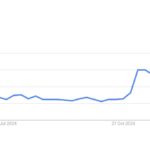In the latest wave of news surrounding Bitcoin, optimism among investors is at an all-time low, as recent market analyses indicate a significant shift in sentiment. Despite long-standing hopes for a retail-driven resurgence in Bitcoin prices, observers from CryptoQuant note that bullish sentiment has dipped to a two-year low, raising concerns about the possibility of a prolonged downturn.
Data from Decrypt highlights that historically, certain indicators could soon signal the end of the current bull cycle for Bitcoin, as shared by well-known analyst Benjamin Cowen. Investors are now on high alert, particularly in the face of recent price fluctuations that have left Bitcoin struggling to break free from the ,000 to ,000 resistance range—a level that market analysts from Bitcoinist believe is crucial for any potential upward movement.
Furthermore, Times Daily reports on the recent price correction that has further complicated the landscape for investors. With many watching closely for a potential catalyst that could lead to a breakout, the air of uncertainty hangs heavily over the market. Bitcoin’s ability to navigate this resistance will be a key factor in shaping future trends as we move forward into the coming months.
“The market’s current state reflects a complex interplay of investor psychology and external factors,” says a prominent market analyst. “Understanding these dynamics will be essential as we look ahead.”

Current Trends in Bitcoin Market Sentiment
The ongoing developments in the Bitcoin market highlight several critical points that could impact investors and the cryptocurrency community at large. Here are the most significant aspects:
- Bearish Sentiment Among Investors: Recent reports show that Bitcoin’s bullish sentiment has hit a two-year low, indicating widespread pessimism in the market.
- Potential Prolonged Downturn: Analysts warn that the bearish sentiment suggests a possible prolonged downturn for Bitcoin prices, which could dissuade new investors from entering the market.
- Resistance Levels: Bitcoin is currently facing resistance at the K-K range, with market analysts suggesting that a significant catalyst is needed for a breakout above these levels.
- Upcoming Indicators: Historical data suggests that certain indicators may soon signal the end of the current bull cycle for Bitcoin, causing existing investors to reconsider their positions.
- Investor Reactions: The recent price correction has led to varied responses from investors, with some choosing to hold while others consider selling to avoid further losses.
Impact on Readers’ Lives:
The current trends in Bitcoin market sentiment can significantly impact readers, particularly those who have invested or are considering investing in cryptocurrency. Understanding market psychology and resistance levels may influence their investment strategies, potentially leading to financial decisions with substantial outcomes.
Bitcoin Market Turbulence: A Deep Dive into Recent Trends
The current landscape of Bitcoin’s market reveals a wave of pessimism among investors, significantly influenced by sentiment indicators and resistance levels that suggest a potential downturn. Recent reports indicate that Bitcoin bullish sentiment has plummeted to a two-year low, raising alarms for those who had been optimistically hoping for a sustained retail rally. This scenario highlights the fragility of market dynamics and the risk of a ‘prolonged downturn’ as indicated by analysts like Benjamin Cowen.
One of the competitive advantages for the pessimistic narrative in the market is the reliance on historical data trends. Analysts are scrutinizing past cycles, where such low sentiment has often preceded significant price corrections. This could appeal to conservative investors looking for stability, prompting a shift away from high-risk engagements during uncertain downturns. In contrast, this pessimism poses a challenge to crypto enthusiasts and retail investors who thrive on market momentum and are now faced with stagnant price movements, such as the ongoing struggle within the K-K resistance range.
Moreover, the implications of these trends extend to various stakeholders. Institutional investors, who often operate with a long-term perspective, might see these indicators as a signal to pause or recalibrate their strategies. On the other hand, active traders may find opportunities presented by volatility, although the thinning bullish sentiment could make it riskier to chase quick profits. Retail investors, however, may experience heightened anxiety, as the fear of further declines can lead to panic selling or hasty decisions that exacerbate market fluctuations.
In essence, the implications of dwindling bullish sentiment and ongoing resistance levels could provide expert traders with an environment ripe for short-term strategy adjustment, while simultaneously, it could dissuade casual retail participants who less adeptly navigate in turbulent waters. As the market holds its breath for a catalyst to reignite upward momentum, the current narrative undoubtedly shapes the strategies adopted by all players involved.

















